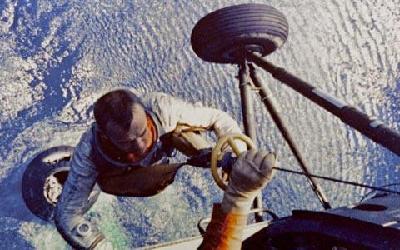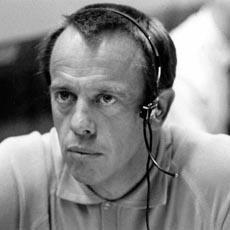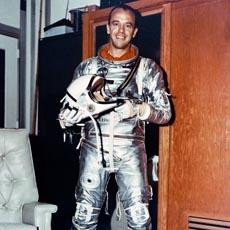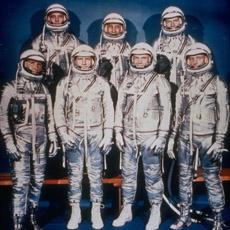
SHIRLEY GRIFFITH: I'm Shirley Griffith.
STEVE EMBER: And I'm Steve Ember with the VOA Special English program People in America. Each week we tell about someone important in the history of the United States. This week we tell about astronaut Alan Shepard, who was the first American to fly in space.
MISSION CONTROL: "Ten, nine, eight, seven, six, five, four three, two, one, zero. Liftoff!"
SHEPARD:"Ah Roger, liftoff and the clock has started."
MISSION CONTROL: [unintelligible]
SHEPARD: "Yes sir, reading you loud and clear. This is Freedom 7. The fuel is go, one point two g, cabin at 14 psi, oxygen is go!"
SHIRLEY GRIFFITH: The clock has started. With those words, Alan Shepard became the first American to travel into space. He was in a small spacecraft called Freedom 7. It was on top of a huge rocket traveling at more than 8,000 kilometers an hour.

Fifteen minutes later, Freedom 7 came down in the Atlantic Ocean. Alan Shepard was a national hero. He had won an important victory for the United States. The date was May 5th, 1961. The United States and the Soviet Union were in a tense competition for world influence. And this competition was reaching even into the cold darkness of space.
STEVE EMBER: In 1957, the Soviet Union launched the first electronic satellite, Sputnik One. The United States successfully launched its first spacecraft less than four months later. Now the two sides were racing to see who could launch the first human space traveler.
On April 12th, 1961, Soviet cosmonaut Yuri Gagarin flew in space for 108 minutes. He circled the Earth once. The Soviets again were winning the "space race," but not for long. Three weeks later the United States also put a man into space. He was a 37-year-old officer in the Navy -- Alan Shepard.
SHIRLEY GRIFFITH: Alan Bartlett Shepard, Junior, was born on November 18th, 1923 in East Derry, New Hampshire. He graduated from the United States Naval Academy in 1944. He married soon after his graduation. Then he served for a short time on a destroyer in the Pacific during World War Two.
In 1947, Alan Shepard became a pilot in the Navy. Later he became a test pilot. The life of a test pilot can be very dangerous. It helped prepare Alan Shepard for an even greater danger in the future.
(MUSIC)
STEVE EMBER: The successes that the Soviet Union had with its Sputnik program caused the United States to speed up its plans for a space program. The Americans decided to launch a satellite as soon as possible. The first attempt failed. The rocket exploded during launch.
Support was growing, in Congress and among scientists, for a United States civilian space agency. Soon, Congress passed a bill creating NASA -- the National Aeronautics and Space Administration. President Eisenhower signed the bill into law.
NASA's job was to be scientific space exploration. Its major goal was sending the first Americans into space.
Within three months, the program had a name: Project Mercury. Mercury was the speedy messenger of the Greek gods. While engineers built the spacecraft, NASA looked for men to fly them.
NASA wanted military test pilots because they test fly new planes. Test pilots are trained to think quickly in dangerous situations. On April 7th, 1959, the space agency announced the seven Mercury astronauts. They would be the first American space travelers. Alan Shepard was one. The others were Scott Carpenter, Gordon Cooper, John Glenn, Virgil Grissom, Walter Schirra and Donald Slayton.
SHIRLEY GRIFFITH: Nine months after the project started, NASA made its first test flight of the Mercury spacecraft from Cape Canaveral, Florida. In the next two years, many other tests followed, all without astronauts.

The final test flight was at the end of January, 1961. It carried a chimpanzee named Ham on a 700-kilometer flight over the Atlantic Ocean. Several problems developed. But Ham survived the launch and the landing in the ocean. Later, Alan Shepard often was asked how he became the first human American to fly in space. "They ran out of monkeys," he joked.
STEVE EMBER: There were some concerns about the safety of the huge Redstone rocket that was to carry the spacecraft. The launch had been delayed several times while more tests were done. By the time the rocket was ready for launch, Yuri Gagarin had already gone into space for the Soviet Union.
The choice of Alan Shepard to be the first American to fly in space was announced just a few days before the launch. Flights planned for May 2nd and May 4th had to be halted because of bad weather.
On May 5th, 1961, a Friday, Alan Shepard struggled once again into his Mercury capsule. The vehicle was named Freedom 7. There was almost no room to move. Shepard waited inside for four hours. Weather was partly the cause of the delay. There were clouds that would prevent filming the launch. Also some last-minute repairs had to be made to his radio.
Shepard was tired of waiting. So he told the ground crew to hurry to solve the problems and fire the rocket. Finally, they did.
SHIRLEY GRIFFITH: The rocket slowly began climbing. Millions of radio listeners heard a voice from the Cape Canaveral control room say: "This is it, Alan Shepard, there's no turning back. Good luck from all of us here at the Cape."
The rocket rose higher and higher. For five minutes, Alan Shepard felt the weightlessness of space. He felt himself floating.
Freedom 7 flew 185 kilometers high. Then it re-entered the atmosphere and the spacecraft slowed. The 15-minute flight ended with a soft splash into the ocean about 500 kilometers from Cape Canaveral.
Alan Shepard reported: "Everything is A-Okay." A helicopter pulled him from the spacecraft and carried him to a waiting ship.
(MUSIC)
STEVE EMBER: The flight was a complete success. Three weeks later, President John F. Kennedy declared a new goal for the United States. He called for "landing a man on the Moon and returning him safely to the Earth" by the end of the 1960s.

In July of 1969 that goal came true. Alan Shepard was not on that first Apollo moon flight. In fact, he almost never made it to the moon. He developed a disorder in his inner-ear.
It kept him from spaceflight for a number of years. Finally, an operation cured his problem. NASA named Shepard to command Apollo 14. The flight was launched at the end of January, 1971. Stuart Roosa and Edgar Mitchell were the other members of the crew.
Roosa orbited the moon while Shepard and Mitchell landed on the surface. They collected rocks and soil. Shepard also did something else. He played golf. He hit two small golf balls.
It was not easy. Shepard was dressed in a big spacesuit. He described his difficulty to Mission Control in Houston.
SHEPARD: "Houston, while you're looking that up, you might recognize what I have in my hand as the handle for the contingency sample return; it just so happens to have a genuine six iron on the bottom of it. In my left hand, I have a little white pellet that's familiar to millions of Americans. I'll drop it down. Unfortunately, the suit is so stiff, I can't do this with two hands, but I'm going to try a little sand-trap shot here."
STEVE EMBER: When Shepard did hit the golf balls, they traveled "for miles and miles," as he reported, because the gravity on the moon is one-sixth of the gravity on Earth.
SHIRLEY GRIFFITH: The only humans to walk on the moon were in the Apollo space flight program. Twelve American astronauts walked on the moon between 1969 and 1972. Alan Shepard was the fifth one.
In 1974, he retired from NASA and the Navy. Shepard became chairman of a building company in Houston, Texas. Later he began his own company, called Seven Fourteen Enterprises. It was named for his flights on Freedom 7 and Apollo 14.
He also wrote a book with astronaut Deke Slayton about his experiences. The book is called "Moon Shot." And he led a group raising college money for science and engineering students.
STEVE EMBER: Alan Shepard died on July 21st, 1998 after a two-year fight with the blood disease leukemia. He was 74 years old. He had been married to his wife, Louise, for 53 years.
Alan Shepard was the first American to fly in space. He rode into the sky on rocket fuel and the hopes and dreams of a nation.
He will always be remembered as an American hero because of those 15 minutes in space.
(MUSIC)
SHIRLEY GRIFFITH: This Special English program was written by Avi Arditti and produced by Lawan Davis. This is Shirley Griffith.
STEVE EMBER: And this is Steve Ember. Join us again next week for another PEOPLE IN AMERICA program on the Voice of America.
leukemia: a malignant progressive disease in which the bone marrow and other blood-forming organs produce increased numbers of immature or abnormal leukocytes. These suppress the production of normal blood cells, leading to anemia and other symptoms. 【醫(yī)】白血病(俗稱血癌)
In race to space, the winner was a Russian
The Rich Are Eyeing Space Tourism, Poll Says
Project mercury: The US space program begins
Excitement and tragedy on road to the moon
(來源:VOA 編輯:崔旭燕)
